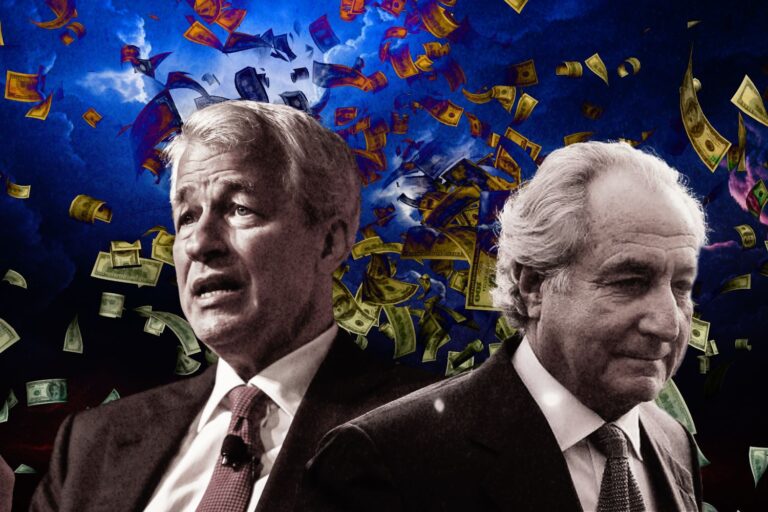The Dark Side of Banking Practices: Unethical Misconducts Unveiled

Banks are considered the backbone of the global financial system, entrusted with the responsibility of managing and safeguarding people’s money. However, over the years, there have been several instances of fraud and unethical conduct within the banking industry that have had far-reaching consequences.
Some of the most notable examples include the Wells Fargo scandal, the LIBOR scandal, and the ETN scandal. These incidences have exerted a significant impact on the banking industry and the wider financial markets, shedding light on issues such as fraudulent practices, market manipulation, and lack of regulatory oversight.
In this article, we will delve into these three scandals, examining the details of each case, their implications, and the lessons that can be drawn from them.
Wells Fargo Scandal: Why Banking Governance and Consumer Protection Matter!
The Wells Fargo scandal, one of the most notable banking scandals in recent years, unfolded in 2016 when it was revealed that Wells Fargo employees had engaged in widespread fraudulent practices to meet aggressive sales targets set by the company.
Evidence showed that employees had opened millions of unauthorized savings and checking accounts in the names of existing customers without their knowledge or consent. These unauthorized accounts were often accompanied by other fraudulent practices such as the issuance of unauthorized credit cards and the transfer of funds from existing accounts to these unauthorized accounts.
Employees also manipulated customer data and created fake email addresses to enroll customers in online banking services without their consent, further compounding the fraudulent activity.
The aggressive sales targets set by Wells Fargo were a key “driver” behind the scandal. Former employees reported that the pressure to meet these targets was intense and that they faced threats of termination, demotion, or denial of promotions if they did not meet their sales goals.
Employees were incentivized to open new accounts and cross-sell products, and their performance evaluations and compensation were tied to meeting these targets. This created a toxic sales culture that prioritized meeting targets at all costs, leading to unethical and fraudulent practices.

As a result, the wrongdoing had severe financial consequences for Wells Fargo. The bank faced numerous lawsuits and legal settlements related to the unauthorized accounts, resulting in substantial financial damages. For example, in 2016, Wells Fargo agreed to pay $185 million in fines to the Consumer Financial Protection Bureau (CFPB), the Office of the Comptroller of the Currency (OCC), and the City and County of Los Angeles as part of a settlement agreement. Additionally, the bank came up against class-action lawsuits from customers and shareholders, leading to further financial liabilities.
Understandably, the scandal triggered a crisis for the bank’s reputation, as customer trust was eroded. Wells Fargo’s customer satisfaction scores dropped sharply, and the bank was snowed under widespread criticism from customers, the media, and regulators.
The consequences of the scandal were not limited to financial damages. The bank’s market value did suffer as a result of the scandal. Wells Fargo’s stock price declined, and the bank’s market capitalization took a hit, resulting in substantial losses for shareholders.
In September 2016, when news of the scandal broke, Wells Fargo’s stock price dropped by nearly 10% in just one week, resulting in a loss of billions of dollars in market capitalization. The scandal also had a lingering impact on the bank’s market value, as investor confidence was shaken and concerns about the bank’s reputation and governance persisted.
In the months and years that followed, Wells Fargo’s stock price struggled to recover and experienced ongoing volatility, resulting in substantial losses for shareholders who saw the value of their investments erode.
Furthermore, it led to changes in the bank’s leadership and corporate governance structure. Wells Fargo’s CEO at the time, John G. Stumpf, resigned in October 2016, and the bank announced additional changes to its board of directors, including the resignation of several board members and the appointment of additional independent directors.
In a statement to CNBC, Wells Fargo said the bank is revising its management, risk and control frameworks while changing the company’s culture and policies. “There’s more work we must do to rebuild trust, and we are committed to doing that work,” the bank said.
“We continue to hold the firm accountable for its deficiencies with an unprecedented asset cap that will stay in place until the firm has fixed its problems,” Federal Reserve Chairman Jerome Powell told reporters at a press conference in late 2021.
The Wells Fargo scandal exposed serious issues related to corporate governance, ethics, and consumer protection in the banking sector. It highlighted the need for stronger internal controls, transparent and ethical sales practices, and robust regulatory oversight to prevent such fraudulent activities.
It also underscored the importance of fostering a culture that prioritizes customer interests and ethical conduct over meeting aggressive sales targets. The scandal served as a stark reminder to the banking industry of the consequences of unethical behavior, the need for responsible corporate governance, and the importance of safeguarding consumer trust to maintain the integrity of the financial system.
The LIBOR Scandal: How Manipulation of a Benchmark Interest Rate Wreaked Havoc!

Different from the previous case, the LIBOR scandal, which emerged in 2012, revealed a widespread manipulation of the LIBOR rate (London Inter-Bank Offered Rate) by a group of major banks. The LIBOR is a benchmark interest rate used as a reference for pricing trillions of dollars of financial products worldwide. Evidence revealed that traders at several banks had colluded to manipulate LIBOR rates to benefit their own trading positions or to make their banks appear more creditworthy during the financial crisis.
For example, Barclays, one of the banks implicated in the scandal, admitted to manipulating LIBOR submissions to benefit its own derivatives trading positions and to portray a more favorable picture of its financial health.
As part of its settlement with regulators, Barclays paid fines of $453 million in 2012, and several of its traders were criminally charged and convicted. Other banks, such as UBS, Royal Bank of Scotland (RBS), and Deutsche Bank, also faced regulatory fines and legal actions related to their involvement in the LIBOR scandal. Collectively, the fines imposed on these banks amounted to billions of dollars.
In addition to the regulatory fines, numerous lawsuits were filed by investors, borrowers, and other parties who were impacted by the manipulated LIBOR rates. For instance, many borrowers, including municipalities, pension funds, and other financial institutions, alleged that they suffered financial harm as a result of paying higher interest rates on loans and other financial products that were tied to LIBOR. These lawsuits resulted in substantial financial damages, with some settlements reaching billions of dollars.
The consequences of the LIBOR scandal extended beyond financial penalties. Criminal charges were brought against individuals involved in the manipulation of LIBOR, resulting in convictions and imprisonment for some.
For instance, Tom Hayes, a former trader at UBS and Citigroup, was convicted in 2015 on eight counts of conspiracy to defraud in connection with LIBOR manipulation and sentenced to 14 years in prison, later reduced to 11 years on appeal. Other individuals from various banks also faced criminal charges and penalties for their role in the scandal.
The implications of the LIBOR scandal were far-reaching, as it undermined the confidence of financial markets in benchmark rates and highlighted the need for greater transparency and accountability in their setting.
The scandal exposed weaknesses in the governance and oversight of benchmark rates, leading to regulatory reforms aimed at enhancing their integrity. For example, regulatory authorities such as the Financial Stability Oversight Council (FSOC) in the United States and the Financial Conduct Authority (FCA) in the UK implemented reforms to improve the calculation, submission, and supervision of benchmark rates. These reforms included stricter reporting requirements, increased regulatory scrutiny, and the introduction of alternative benchmark rates to replace LIBOR.
“The LIBOR scandal has shaken the foundations of the financial industry, highlighting the urgent need for greater transparency and accountability in benchmark rate-setting.” – Financial expert
To sum up, the LIBOR scandal was a striking event that exposed the manipulation of a benchmark interest rate by a group of banks, resulting in regulatory fines, lawsuits, and criminal charges. The evidence of collusion and manipulation by traders, the substantial financial damages from lawsuits, and the criminal convictions of individuals involved in the scandal provide evidence of the magnitude of the issue.
The ETN Scandal: Allegations of Market Manipulation and Impact on Complex Financial Products

The exchange-traded notes (ETN) scandal unfolded in recent years, involving allegations of misconduct by banks such as UBS Group, Citigroup, and Credit Suisse in the trading and pricing of ETNs. These allegations were supported by evidence gathered through regulatory investigations and legal proceedings.
For those who may be unfamiliar with exchange-traded notes (ETNs), it’s important to note that ETNs are unique financial instruments that are distinct from other investment products. ETNs are debt securities issued by banks and traded on stock exchanges, promising to pay a return based on the performance of an underlying index or benchmark.
Unlike traditional investments, ETNs do not hold underlying assets, but rather derive their value from the performance of the reference index or benchmark. ETNs are known for their complexity, involving factors such as leverage, derivatives, and other complex strategies, which can make them more intricate and riskier compared to other investment options.
One example of alleged market manipulation was the practice of front-running, where banks were accused of placing orders ahead of their clients’ orders to profit from price movements in ETNs. This was done by exploiting information asymmetry and prioritizing their own trading interests over those of their clients. Evidence of such front-running practices was uncovered through regulatory investigations, including email exchanges and trading records that indicated suspicious trading patterns.
Another alleged improper trading practice was washing trading, where banks were accused of executing trades between different accounts, they controlled to create a false impression of market activity and manipulate the prices of ETNs. This misconduct was to create artificial demand or supply for ETNs and distort their prices. Evidence of wash trading was found through transaction records and trade data analysis, which revealed suspicious trading patterns and matched orders between accounts with common ownership.
The impact of these alleged market manipulation and improper trading practices was devastating, as it eroded the integrity of the ETN market and harmed investors. Investors who purchased or sold ETNs at manipulated prices may have suffered financial losses, and the overall market confidence in ETNs as complex financial products was shaken.
As a result, regulatory authorities launched investigations into the alleged misconduct by banks involved in the ETN scandal. For example, the U.S. Securities and Exchange Commission (SEC) and the Commodity Futures Trading Commission (CFTC) conducted investigations into the trading practices of banks such as UBS Group, Citigroup, and Credit Suisse, and imposed financial penalties on some of these banks.
For instance, in 2020, UBS Group agreed to pay a $10 million penalty to settle allegations of improper trading practices in ETNs, as reported by the SEC.
In addition to regulatory investigations, lawsuits were filed by investors who suffered financial losses due to the alleged market manipulation and improper trading practices. These lawsuits sought damages for the harm caused by the alleged misconduct of banks. While the outcomes of these lawsuits may vary, they highlight the legal repercussions that banks may face as a result of their involvement in the ETN scandal.
The ETN scandal underscored the need for enhanced oversight and regulation of complex financial instruments like ETNs. It revealed weaknesses in the regulatory framework governing these products, including potential information asymmetry, lack of transparency, and insufficient accountability. As a result, there have been calls for stricter regulations, increased transparency in pricing and trading practices, and improved investor protections for complex financial products like ETNs.
Lessons Learned and Implications for the Future of the Banking Sector
Conclusively, the Wells Fargo, LIBOR, and ETN scandals have brought to light the critical importance of ethical conduct, compliance, transparency, and accountability in the banking industry. These scandals have revealed the severe consequences of unethical practices, market manipulation, and inadequate regulatory oversight.
Moving forward, it is essential for the banking sector to prioritize and uphold high ethical standards, implement robust compliance processes, ensure transparent and accountable practices, and foster a culture of integrity. This includes promoting ethical decision-making at all levels, strengthening regulatory oversight and enforcement, enhancing transparency in financial products and markets, and holding individuals and institutions accountable for misconduct.
The implications of these scandals for the future of the banking sector are far-reaching. There is a growing need for increased vigilance, regulatory reforms, and proactive measures to prevent similar scandals from occurring in the future. This includes continued efforts to strengthen regulatory frameworks, enhance risk management practices, and promote a culture of compliance and ethical behavior within financial institutions.







